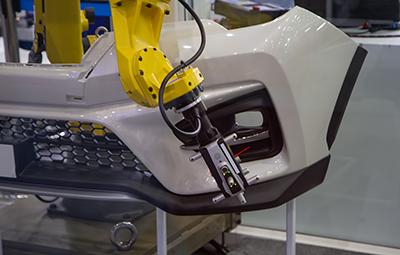Is Robotic Laser Metrology the Right Inspection Process for You?

Robotic laser metrology is a cutting-edge technology that’s changing the game in manufacturing inspection. Automated laser metrology often includes a six-axis robotic arm combined with laser radar technology. By putting these two advanced technologies together, previously unseen levels of productivity, speed, and accuracy are made possible for part inspection.
The automotive, aviation, space, and defense industries in particular have found robotic laser metrology to be helpful in their inspection processes. Robotic laser metrology gives manually-intensive inspection applications meaningful bottom-line results.
Laser Metrology Solves Inspection Woes
Adding a robot with a laser metrology head to an inspection operation can solve the problems in an inspection process. Removing bottlenecks and human error can give manufacturing facilities the edge they need over their competition. Quality control is often quickly improved when deploying a laser metrology robot.
To solve a bottleneck, manufacturers should first start small. It’s usually not a good idea to make a large investment into a robotic cell without some testing. Automating one task at a time can help manufacturers ease into automated inspection smoothly.
Signs of potential bottlenecks include decreased throughput, accumulation, sudden capacity issues, and wait times. It’s best to first list all potential bottlenecks. Since inspection tasks are generally carried out by the same engineers, it can be difficult to identify an individual task as the bottleneck.
Do You Need a Laser Metrology Robot?
Think your facility could use a laser metrology robot? Here are five steps to help you decide if your inspection process could be automated.
- Break down your inspection. Inspection usually includes multiple, interdependent tasks — take a detailed audit of each individual step in your inspection process. Some of these tasks are easy to automate, while some are not.
- Define your data. Your inspection will most likely include different types of data. Identify which types of data are recorded at each step. Robots are better suited to collect some types of data than others.
- List your devices. Perform an audit of the tools and devices used during the inspection process. Some can be manipulated by robots while others typically can’t be.
Assess your tasks. Like with tools and devices, not every task is suitable for robotics. Basically speaking, robots excel at two types of inspection tasks: positioning a sensor or probe to take a measurement, or loading items into a testing machine.
- Pick the best task. Going through steps 1-4 should yield a list of tasks that a robot could perform. You can now evaluate which step to first test a robot on. If you’re not sure which task to choose, talk to one of the experts.
Find out how Genesis Systems can enhance your inspection processes with a Genesis laser metrology solution.
Posted in Uncategorized